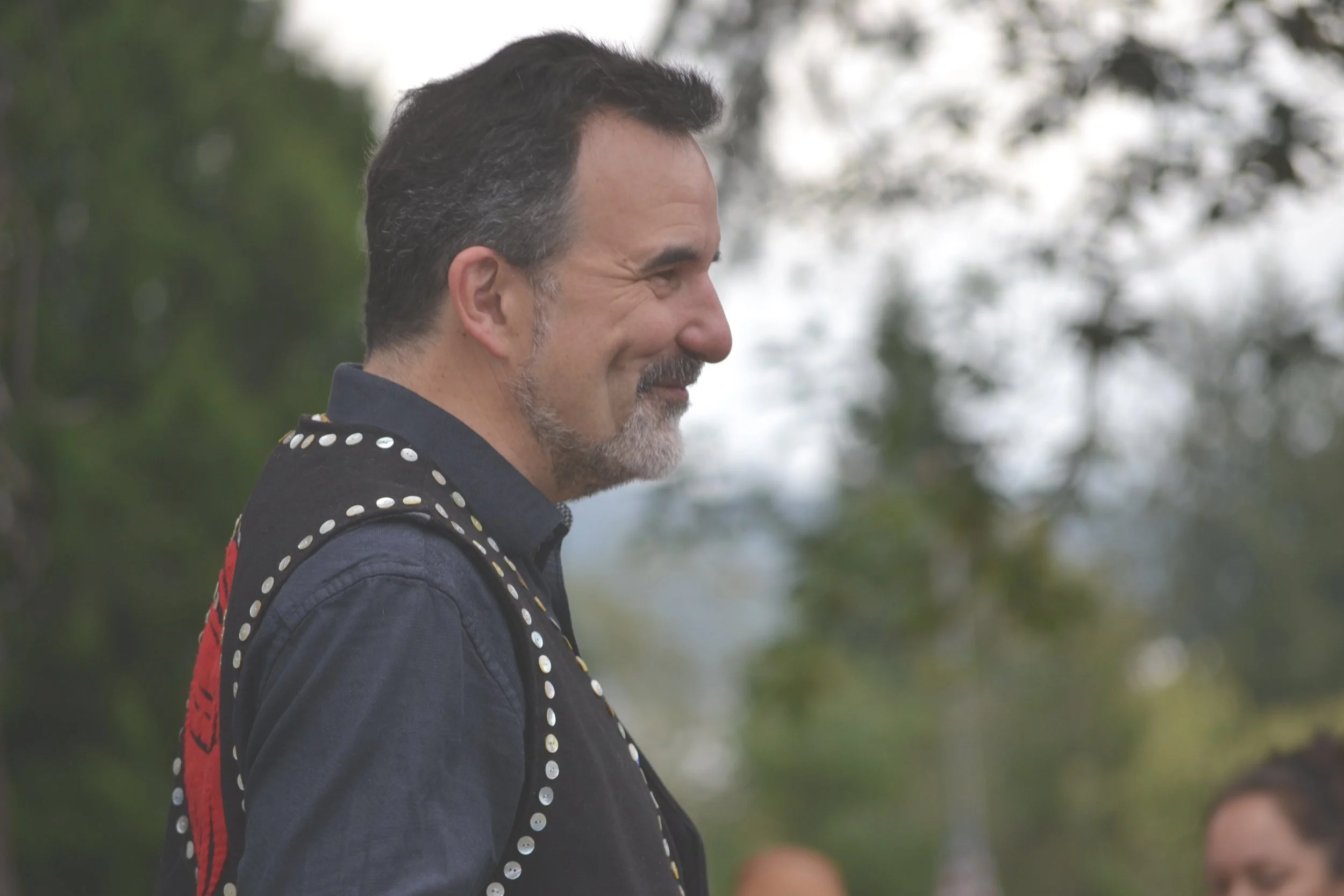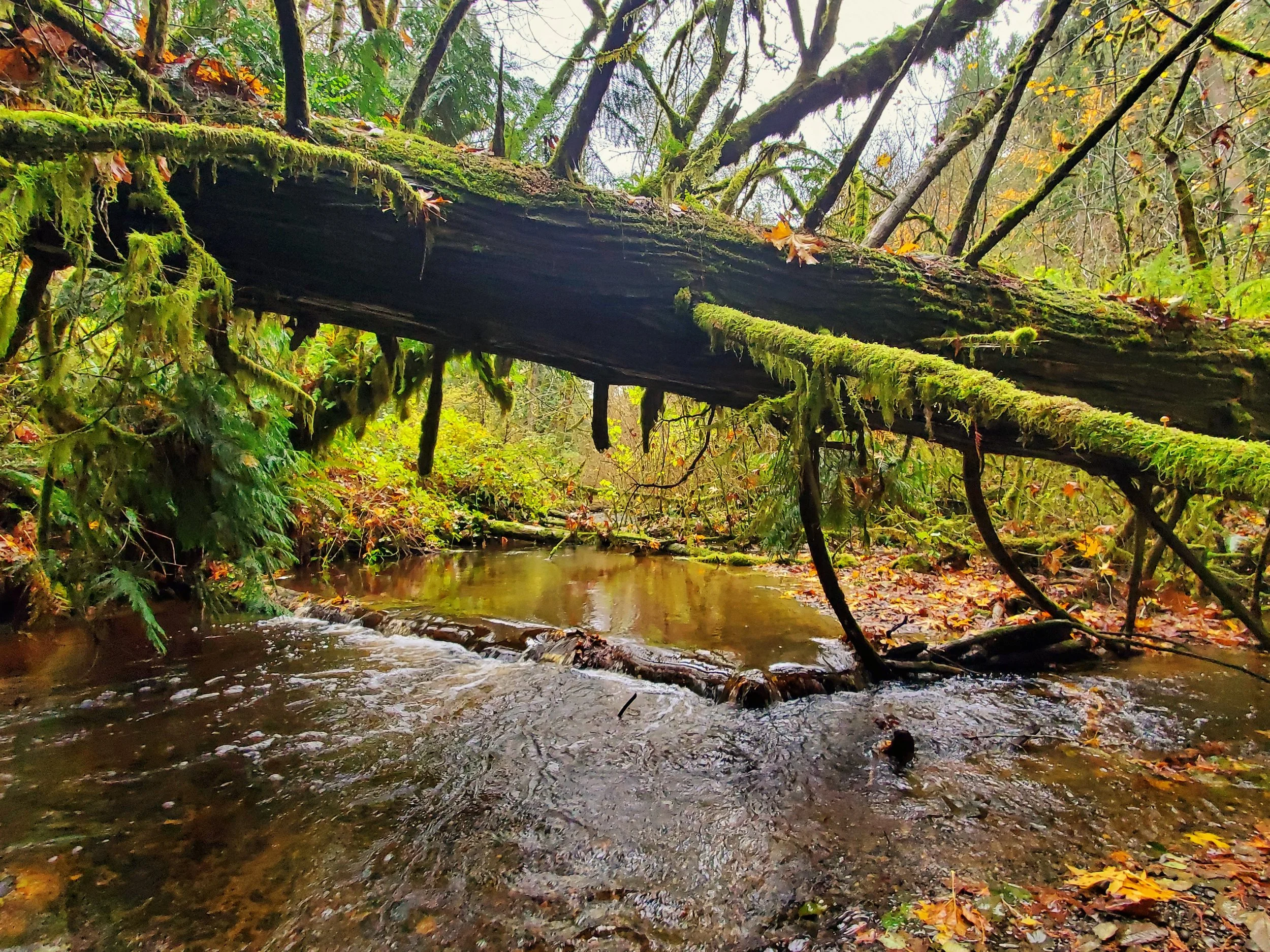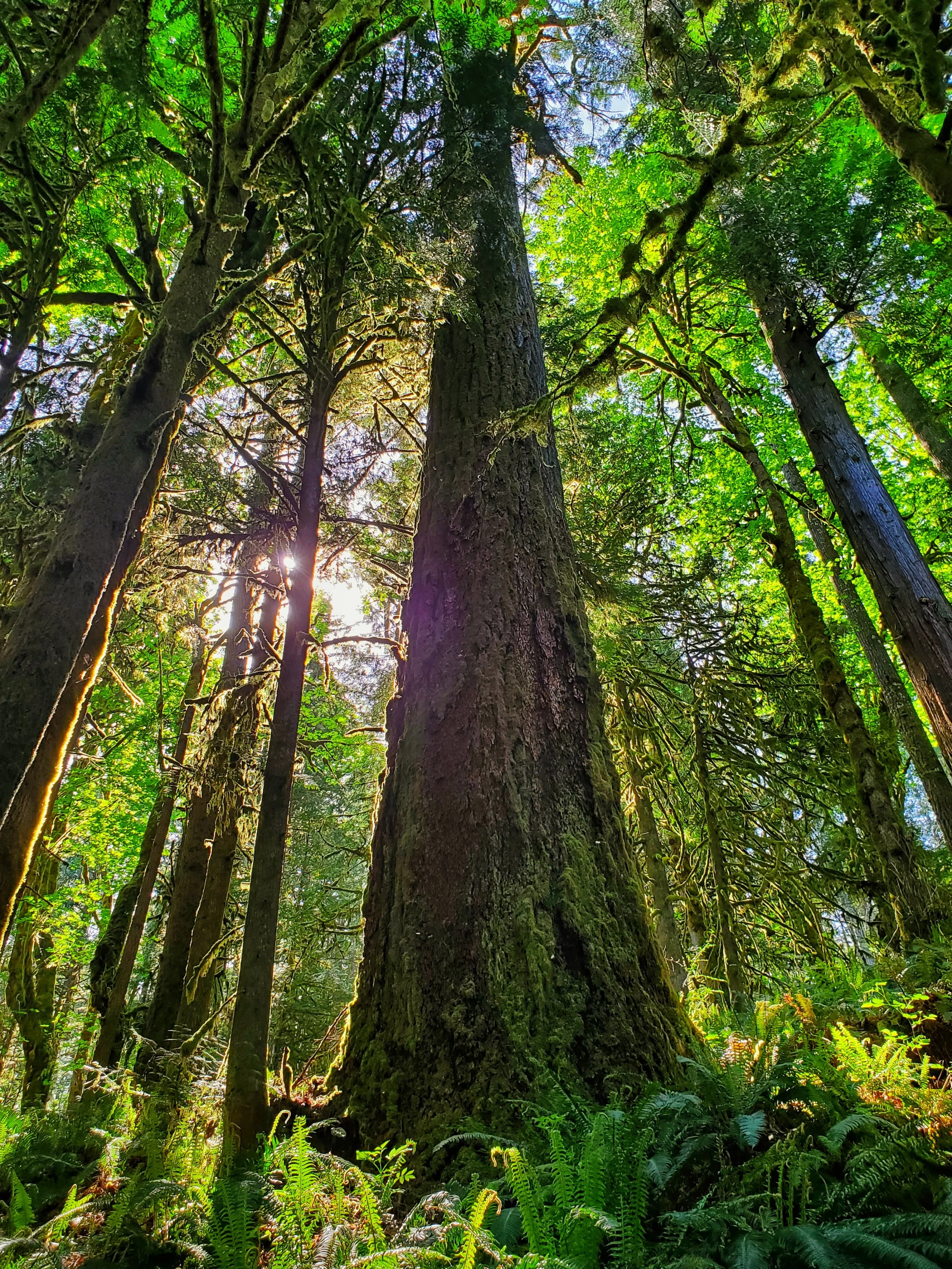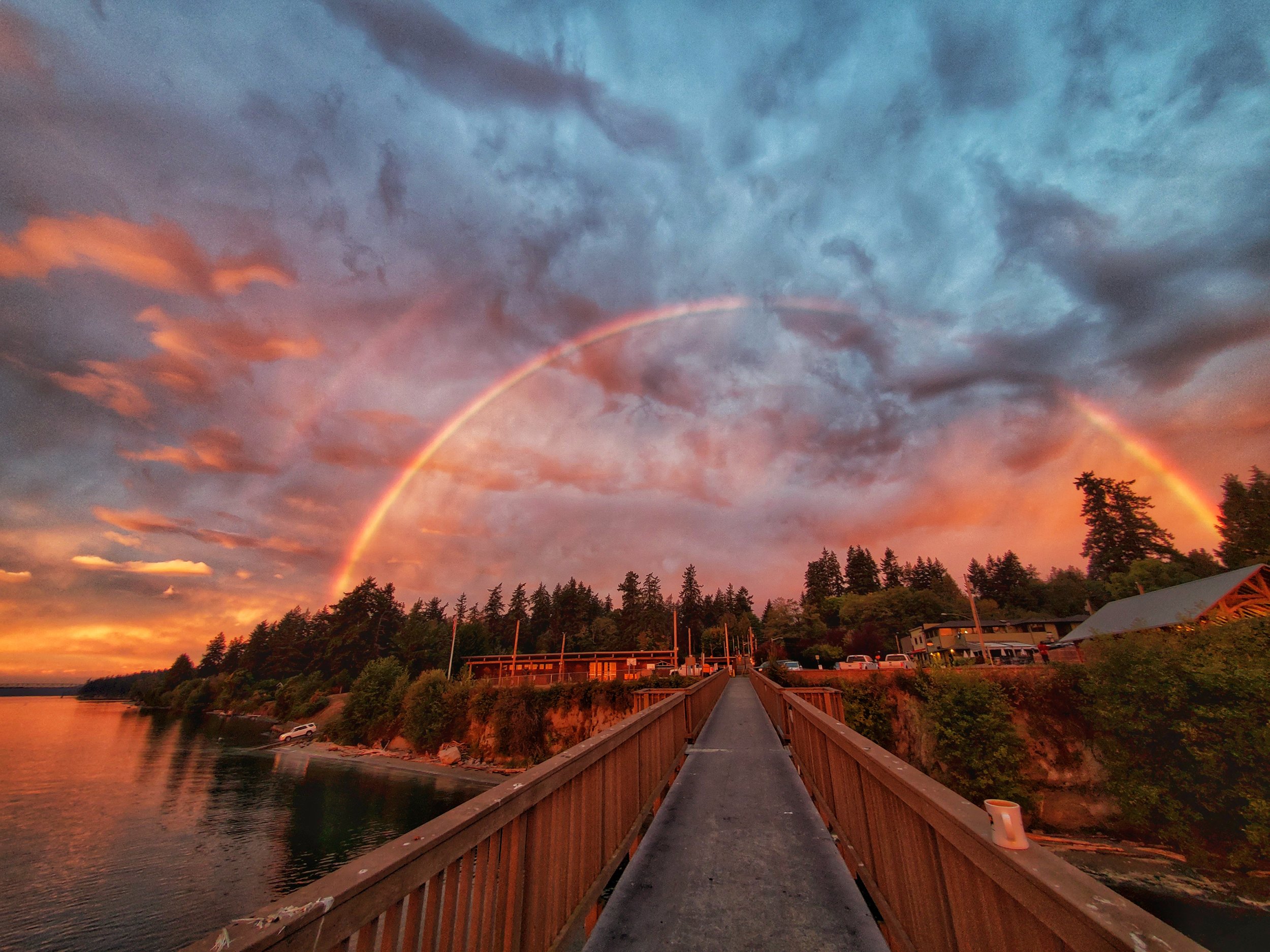stewards of the salish sea
Suquamish Tribe Carries on Chief Seattle's Legacy
Words by Leif Utne
Sunrise in Suquamish during the 2019 Canoe Journey (Photo: Suquamish Tribe/Jon Anderson)
Tom Ostrom meets me at the mouth of Chico Creek, the biggest salmon stream on the Kitsap Peninsula and a traditional fishing spot for the Suquamish Tribe. Ostrom is the Tribe’s director of ecosystem recovery. He oversees a team of nine biologists who work with state and local agencies on fish habitat restoration projects like this one.
Today, the creek gushes out of a 400-foot culvert into Chico Bay. Built in the 1960s, parallel tunnels channel the creek under a massive berm supporting State Highway 3 just north of Bremerton. This is the site of the largest fish barrier removal project in Kitsap County to date.
Culverts can create a host of problems, Ostrom explains. Water passing through these concrete tunnels picks up speed and lacks the turbulence found in a natural stream that makes it easier for fish to swim upriver. During heavy rains, the upstream end of a culvert can get clogged with debris, making it nearly impassable for fish. Meanwhile, water crashing out of the downstream end eats away the streambed, making the jump too high for some migrating fish.
This particular culvert isn’t so bad for adult salmon, like the chums that return here by the thousands every November. But smaller fish, like juvenile chum, coho and steelhead, have a harder time. State biologists estimate that this culvert blocks as much as 15% of the fish that return to spawn in Chico Creek each year. Over the next two years, the Washington State Department of Transportation will spend an estimated $58 million to rebuild the SR 3/Chico Way interchange, replacing the culvert and berm with a bridge and restoring the creekbed to a fish-friendly state.
The project is one of the Suquamish Tribe’s many efforts to help save struggling salmon populations.
A sacred duty
For some, being an environmentalist is a choice. For Leonard Forsman, it’s a sacred duty, a matter of survival. Forsman, 59, is the chairman of the Suquamish Tribe. During his 16-year tenure, the Tribe has established itself as one of the most powerful forces for conservation in the Puget Sound region, and Forsman has earned a national reputation as an environmental leader.
The Suquamish Tribe has invested heavily in environmental protection, plowing profits from its Tribal businesses into hiring teams of lawyers and biologists who work with neighboring governments (occasionally taking them to court) to protect and restore the habitats that have sustained their traditional food sources for millennia.
Suquamish Tribal Chairman Leonard Forsman (Photo: Suquamish Tribe/Jon Anderson)
Forsman is a rising star. In addition to his duties as Tribal chairman, he serves as president of the Affiliated Tribes of Northwest Indians and co-chairs the climate change committee of the National Congress of American Indians. He sits on numerous intergovernmental boards dealing with the health of Puget Sound. Last October, Governor Jay Inslee appointed Forsman to the Board of Regents of his alma mater, the University of Washington. Forsman has used his growing platform to sound the alarm for greater environmental protection.
“The Northwest Tribes have been engaged in restoration of our ecosystems for decades, often by ourselves,” he told a White House summit of tribal nations last November. “We’re in a crisis situation with our salmon runs…due to warming waters and increasing development pressures.”
He called for the removal of three dams on the Lower Snake River that threaten Columbia River salmon and steelhead runs and praised the Biden administration for expanding funding to remove fish barriers throughout Washington State. (In 2018, the Suquamish Tribe won a U.S. Supreme Court case requiring the state to remove over 400 culverts from streams throughout Western Washington.)
Treaty rights
How did this relatively small tribe, just 1,200 members strong, become such an environmental juggernaut? The key is treaty rights.
Chief Seattle, leader of both the Suquamish and Duwamish Tribes, was one of several chiefs who signed the 1855 Treaty of Point Elliott, ceding millions of acres of land to the U.S. government in exchange for peace with white settlers. That treaty and others signed by Northwest Tribes guaranteed reservations for the Tribes and recognized their rights to hunt and fish in their “usual and accustomed grounds and stations.”
But for over a century, the government largely ignored the Indigenous treaty rights. Washington State imposed increasingly restrictive regulations on Native fishermen, limiting them to fishing on reservations and banning some traditional practices like gillnetting.
In the 1960s, Native American activists staged a series of “fish-in” protests at traditional fishing spots around Puget Sound, risking arrest, and even beatings, to assert their treaty rights. The Fish Wars, as this episode is known, earned the tribes nationwide sympathy as celebrities like Marlon Brando and Buffy Sainte-Marie showed up to support them.
The Tribes and the federal government sued Washington State, and in 1974, Judge George Boldt ruled that the Tribes had a right to half of all the harvestable fish throughout Puget Sound, the Pacific Coast and the Columbia River basin. The U.S. Supreme Court upheld Boldt’s ruling five years later, a landmark decision that reshaped the local fishing industry and governs Northwest fisheries to this day.
“Boldt did not grant a right to the Tribes,” says attorney Rit Bellis, who retired in December as the Suquamish Tribe’s legal director. “It was a recognition of a right that has existed since time immemorial.” The Boldt Decision established the Suquamish Tribe’s usual and accustomed range as one of the largest among local Tribes, covering most of Puget Sound, from the northern tip of Vashon Island to the Fraser River in Canada.
Over the past 40 years, Suquamish Tribal attorneys have notched numerous victories for the environment, leveraging their treaty rights to force everyone from the U.S. Navy to King County to reduce pollution in the Puget Sound.
Restoring Chico Creek
From the Chico Creek estuary, Ostrom takes me a couple of miles upstream to the Chico Salmon Viewing Park, the site of a culvert that has already been replaced. What’s now a 140-foot bridge spanning the creek at Golf Club Hill Lane used to be a railroad berm with a concrete culvert underneath.
In 2019, Kitsap County and the Suquamish Tribe collaborated on the $4.4 million project to remove the old berm and culvert and restore the streambed. An engineered system of interlocking logs buried under the creek bottom mimics the undulating, varied conditions found in a natural stream. There is a deep channel with a faster current. But its winding path creates the kind of turbulent eddies salmon love as it swirls around submerged logs and rocks. Now there are sandbars and shallow side channels where smaller fish can rest and adult salmon can spawn, laying their eggs before they die.
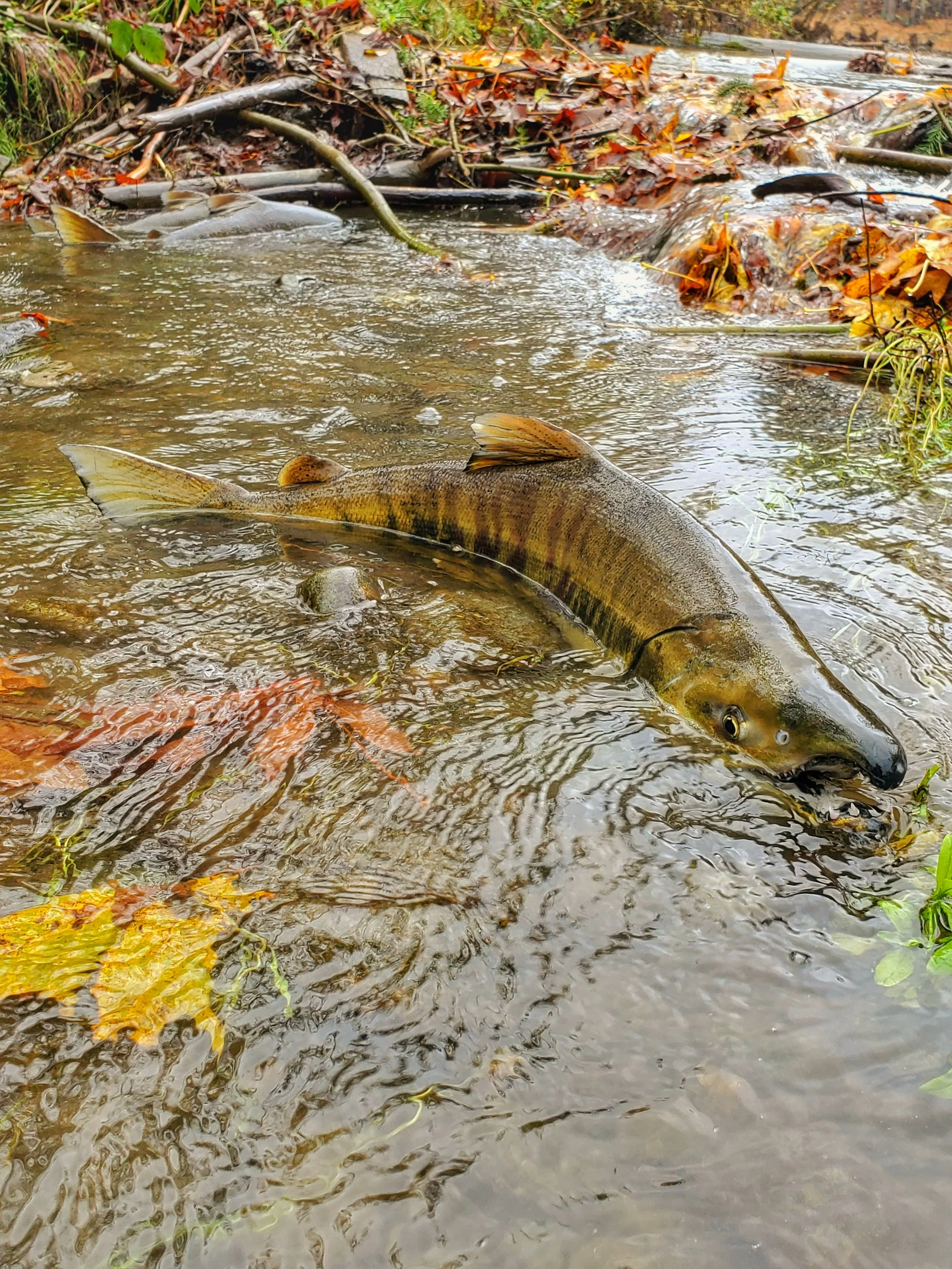
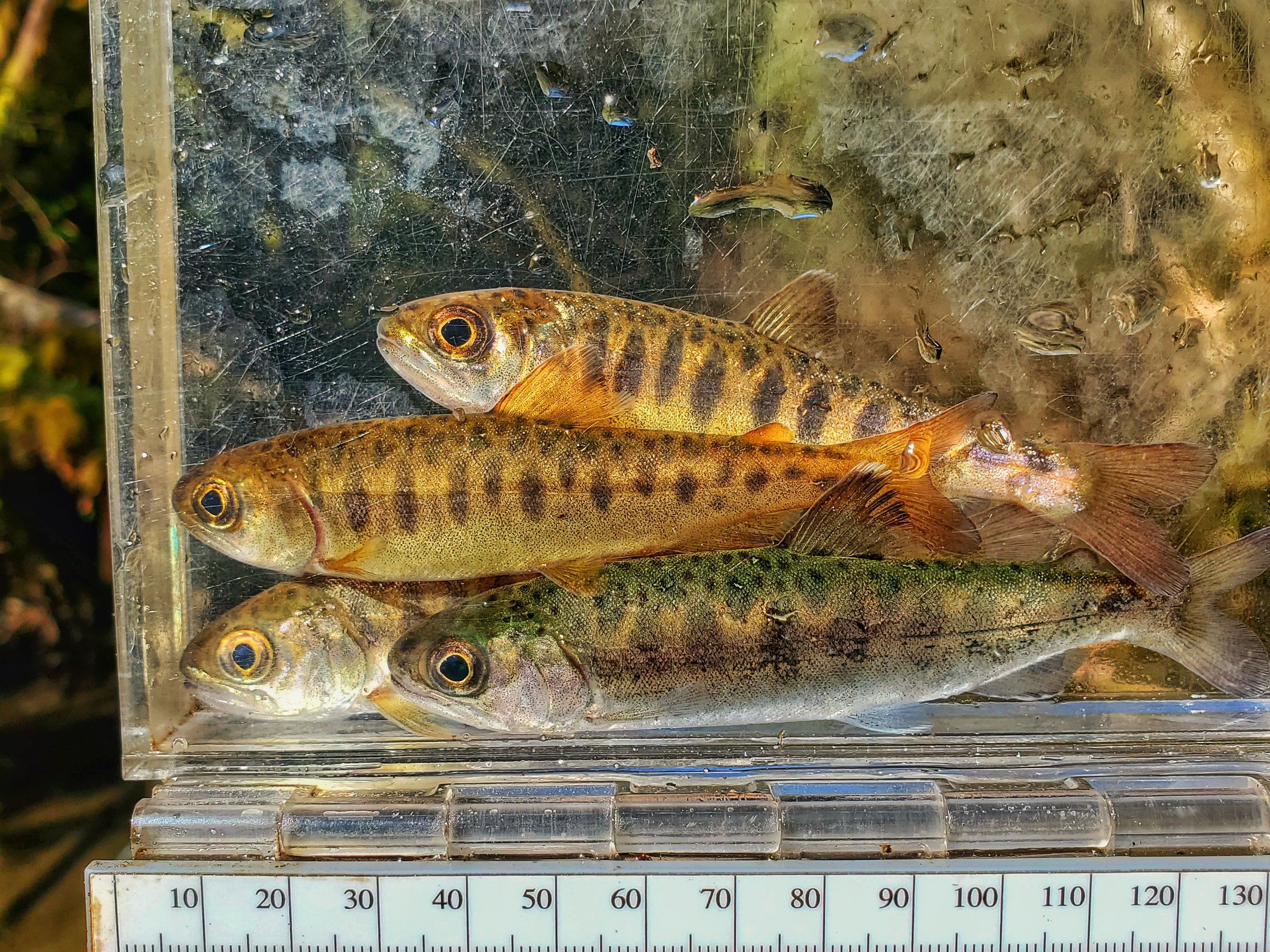


Photos: Jon Oleyar
Ostrom points to a sandbar where a flock of seagulls battles over a decaying chum. It’s about two weeks since the end of the chum run, but we’re witnessing an important part of the fish’s life cycle. A healthy salmon run doesn’t just mean large numbers of fish. It also means a healthy forest. Salmon bring ocean nutrients far upstream into the woods, where they are eaten by bears, birds, smaller fish and insects. Carnivores carry their bodies up from the banks where microbes break down the leftovers into the soil, feeding the forest. This is nature’s fish fertilizer.
“You can even find traces of salmon DNA in the trees,” Ostrom says with a grin.
‘It’s complicated’
Fish conservation is a fractious field full of competing priorities and disagreements over the quickly evolving science. Virtually everyone I spoke to for this article eventually shrugged their shoulders, sighed, and said, “It’s complicated.”
Non-tribal anglers and conservation groups prioritize saving wild fish over all else and argue that hatchery salmon and tribal gillnets accelerate their demise. Tribes tend to prefer releasing more hatchery fish to ensure their supply for religious and ceremonial practices. They point to pollution, climate change and habitat loss as the main threats to wild stocks.
Early Fall salmon survey on Dogfish Creek in Pt Orchard (Photo: Jon Oleyar)
Occasionally, science throws everyone a curveball, like the 2020 finding by UW researchers that a chemical additive in tires is killing as many as half of all returning coho salmon before they spawn.
If there’s one thing everyone can agree on, it’s the importance of habitat restoration.
“We’ve been pretty successful in things we’ve done in our area,” said Rob Purser, the Suquamish Tribe’s Fisheries Director for the past 30 years. “But you look at the whole Salish Sea, at the big picture, we are still losing ground…we need to reverse that to the point where wild fish have a chance to repopulate in the future.”
Several observers I spoke to praised the Tribe’s work on habitat. “The Suquamish Tribe and Chairman Forsman are extremely strong environmental leaders amongst Western Washington Tribes,” said Kitsap County Commissioner Rob Gelder, who got to know Forsman a decade ago when the two served on a coordinating body under the Puget Sound Partnership. “Kitsap County has long had a strong working relationship with the Suquamish Tribe, without which the habitat restoration milestones we’ve made along Chico Creek and elsewhere would not have been possible.”
Coming full circle
Finally, Ostrom and I drive a few miles further upstream to the Keta Legacy Foundation's rhododendron preserve, an oasis of old-growth forest where tribal biologists count several fish species to monitor the populations and health of local runs. We hike down a steep hillside past huge cedars, Douglas firs and hemlocks, the forest floor covered with majestic sword ferns, salal, Oregon grape and huckleberry. A gap in the canopy lets in a beam of sunlight, which turns the mossy trunk of a bigleaf maple a brilliant Kelly green.
Old growth Douglas fir in Keta Legacy Rhododendron Preserve (Photo: Jon Oleyar)
Descending deeper into the canyon I smell Wildcat Creek (a tributary to Chico) before I see it. The pungent, semi-sweet odor of decaying fish hangs in the air. From a mossy footbridge I spot a dozen dead chums in a short bend in the shallow creek, their pink remains wrapped around rocks and branches in the rushing water. Having safely deposited their eggs in this idyllic spot—I hope—they’ve given up the ghost, sacrificing their bodies to start the cycle anew.
Chief Seattle’s legacy
In an 1854 speech to Gov. Isaac Stevens, before signing the Treaty of Point Elliott, Chief Seattle said, “Every part of this soil is sacred in the estimation of my people. Every hillside, every valley, every plain and grove, has been hallowed by some sad or happy event in days long vanished.”
For Chairman Forsman, honoring the legacy of the chief who once led his Tribe by fighting to protect these lands and waters is an obligation, despite the odds. “We’re in a race against time,” he says. “The region’s salmon runs have been on life support for decades and continue to face extinction, as do our orca relatives. Climate change and ocean acidification make these threats even more dire.”
“We would do this work whether or not we were hopeful of success,” he continues. “We inherited this responsibility from our ancestors, and we do this work because our culture, our way of life, and our future relies on healthy marine ecosystems. We owe this work to future generations.”
A rainbow over Suquamish (Photo: Jon Oleyar)


